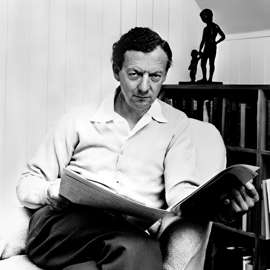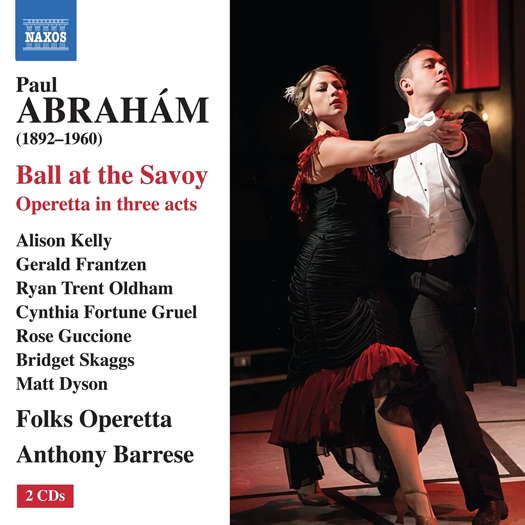- Die Fledermaus
- accordion
- Saulius Sondeckis
- Ylivieska
- Negro Melodies
- Nina Warren
- Ian Stephens: Oboe Quintet
- Robert Shaw
 DISCUSSION: John Dante Prevedini leads a discussion about Music and the Visual World, including contributions from Celia Craig, Halida Dinova and Yekaterina Lebedeva.
DISCUSSION: John Dante Prevedini leads a discussion about Music and the Visual World, including contributions from Celia Craig, Halida Dinova and Yekaterina Lebedeva.
 SPONSORED: Ensemble. Last Gasp of Boyhood. Roderic Dunnett investigates Jubilee Opera's A Time There Was for the Benjamin Britten centenary.
SPONSORED: Ensemble. Last Gasp of Boyhood. Roderic Dunnett investigates Jubilee Opera's A Time There Was for the Benjamin Britten centenary.
All sponsored features >>

Innovative and Different
Paul Abrahám's operetta 'Ball at the Savoy' impresses GERALD FENECH
'... the performance has a rhythmic energy that keeps the music flowing effortlessly from start to finish ...'
Born on 2 November 1892, Paul Abrahám was a Jewish-Hungarian composer who attained major successes in the German-speaking world with his innovative stage-works. Like many other composers of operettas, Abrahám started off with works of a serious nature. During the decade following his studies at the Royal National Hungarian Academy of Music in Budapest (1910-1916) he wrote, among other things, sacred music, string quartets and a cello concerto. When he was appointed conductor at the Budapest Operetta Theatre in 1927 he found his way to this more popular art form which was more suited to his talents.
His first operetta, Der Gatte des Frauleins, was written in 1928, but it was with the third in the genre, Viktoria und ihr Husar (1930), that he scored his first resounding success. The rise of Nazi Germany in 1933 forced Abrahám to abandon his beloved Berlin, being unwanted both as a Jew and as the composer of Die Blume von Hawaii, which was considered a piece of 'degenerate art', telling the story of a German sailor who falls in love with a Hawaiian girl.
Via Vienna and Paris he moved to Cuba, where he earned a modest living as a pianist. He later emigrated to New York, where in 1946 he was admitted to the Bellevue Hospital in Manhattan suffering from a mental breakdown. In May 1956 he returned to Hamburg where he continued to receive treatment for his ailments. He died on 6 May 1960, aged sixty-seven.
Together with the two operettas mentioned above, Ball im Savoy completes the trio of his most successful compositions. Premiered on 23 December 1932 in Berlin, this three-act piece hit it straightaway. The English-language premiere was on 8 September 1933 at the Drury Lane Theatre in London, under the title 'Ball at the Savoy' with the libretto adapted by Oscar Hammerstein. This was the composer's last major success. Although the work is a relatively recent operetta, its characters follow the classic scheme: a man tells a load of lies to his wife so he can scamper off to a ball, and she, on the other hand, gets her revenge by going to the same ball in disguise.
Listen — Paul Abrahám: Prelude (Ball at the Savoy)
(CD1 track 1, 0:15-1:04) ℗ 2021 Naxos Rights (Europe) Ltd :
Abrahám wanted his stage-works to be innovative and different from the norm, and the insertion of jazz interludes into his operettas was not only a masterstroke but a future trademark of what was to follow. The score of Ball at the Savoy is more modern than the libretto by Alfred Grunwald and Fritz Lohner-Beda, using an abundance of foxtrots and Latin American dances like tango and paso doble. However, it also features the waltz in its classic shape.
Listen — Paul Abrahám: Nobody wants to do the foxtrot today (Ball at the Savoy Act I)
(CD1 track 12, 0:00-0:57) ℗ 2021 Naxos Rights (Europe) Ltd :
In Abrahám's own words, his primary aim was to search for success, one eye to Broadway theatre, and the other to the cinema. This world premiere recording of the English version was taped in November 2014 at the Percy Julian Auditorium in Illinois, and arrangers Anthony Barrese, Mathias Grimminger and Henning Hagedorn could not have done a better service to the composer. Indeed, the performance has a rhythmic energy that keeps the music flowing effortlessly from start to finish, and the quality of the singing is just superlative.
Listen — Paul Abrahám: I’ll have a ball at the Savoy (Ball at the Savoy Act III)
(CD2 track 19, 0:00-0:49) ℗ 2021 Naxos Rights (Europe) Ltd :
Barrese's complete commitment to the cause is also evident in how he captures the essence of the 1930s with uncanny ability. Beautifully recorded and presented, this is a Ball you cannot afford to miss. So take the plunge and let your hair down.
Copyright © 22 August 2021
Gerald Fenech,
Gzira, Malta

CD INFORMATION - ABRAHÁM: BALL AT THE SAVOY
MORE BERLIN AND CLASSICAL MUSIC ARTICLES
MORE ARTICLES ABOUT HUNGARY AND CLASSICAL MUSIC


